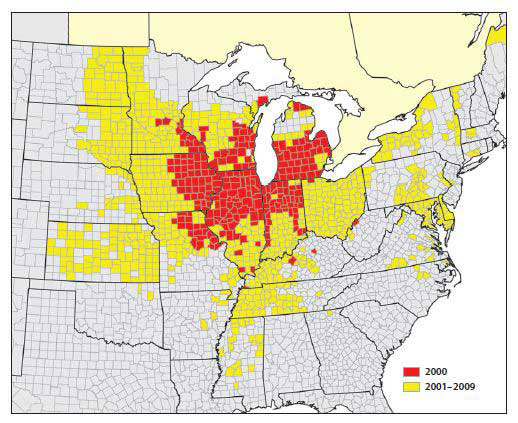Soybean aphids (SBA) are minute (less than 1/16th inch long), soft-bodied, pear-shaped insects. They may vary in color from pale yellow to light green and have black cornicles on the back of their abdomen. There are winged and wingless forms depending on the time of season, population densities, and environmental conditions.

Credit: soybean aphid image courtesy of Ho Jung Yoo: Purdue University Photo
Life Cycle
Soybean aphids overwinter as eggs on buckthorn. In the spring, the eggs hatch into wingless females, which will complete 2 to 3 generations on buckthorn. In early June, the aphids produce a generation of winged females that will migrate into newly emerging soybean fields. When conditions are favorable, aphids can reproduce very quickly on soybeans, potentially doubling their population in 2 to 3 days and producing up to 18 generations on soybean per season. In the fall, a generation of winged males and females will emerge and migrate to buckthorn where they will mate, lay eggs to overwinter, and begin the cycle again.
Aphids cause damage by removing plant sap with their piercing and sucking mouthparts. With heavy infestations, the leaves become wilted and curled and plants may become stunted with poor canopy. A charcoal-colored residue may be seen where aphids are feeding. This is caused by a sooty mold that grows on the honeydew that is excreted by the aphids. Soybean aphids can decrease yields by affecting seed quality, seed size, and pod number. Soybean aphids can also transmit soybean mosaic virus. Yield reductions of 40 percent or greater can occur in heavily infested fields if left untreated.

Distribution
Soybean aphids were first discovered in Wisconsin in 2000 and have since spread throughout the North Central production region, as far south as Alabama, and into three Canadian provinces.
Management
Regular scouting once or twice a week is crucial for determining aphid population densities, which will dictate when to apply chemical control. Begin scouting no later than the R1 growth stage (beginning bloom) and continue through pod fill. The action threshold for insecticide treatment is 250 aphids per plant over 20-30 plants sampled throughout the field with 80 percent of the plants infested. This threshold gives a 5-7 day lead time to take action before the population reaches a level that can begin to cause measurable yield loss, which is estimated to be around 675 aphids per plant. Spraying soybeans at this threshold works well from the R1 through R5 growth stage, which is when soybeans are most at risk for yield loss due to aphid feeding. Spraying at or beyond growth stage R6 has not been documented to effect yield enough to justify treatment.
Before using a chemical control, look for the presence of beneficial insects such as lady beetles and minute pirate bugs. Also look for mummified aphids, which indicate the presence of parasitoids in the field. Fungal infections can also contribute to aphid mortality. Pay attention to environmental conditions in the forecast that can decrease aphid populations, such as high temperatures above 85° F and heavy rains. Note the presence of winged aphids in the population as a large number of these may indicate that the aphids will soon leave the field. If environmental conditions are not favorable for population growth, large numbers of natural predators and mummified aphids are present, and/or a majority of the aphids are winged or developing wings, spraying may not be necessary.
Several insecticides are labeled for control of SBA. Good insecticide coverage and penetration into the soybean canopy is important for optimal control. Use aerial application with high water volume and pressure. Pyrethroids have a long residual and work best at temperatures below 90° F. Organophosphate products have a fuming action and may work well in heavy canopies or at high temperatures.
Host plant resistance for SBA uses two forms of resistance – antibiosis (reduces lifespan, reproductive potential, or causes death) and antixenosis (inhibits colonization). The genes conferring the resistance are referred to as Rag for Resistant Aphis glycines. Currently, resistant soybeans are commercially available but in limited quantity and only for select maturity groups.
Sources:
1 Hunt, T. and K. Jarvi. Soybean Aphid Biology and Management in Nebraska. CropWatch. University of Nebraska-Lincoln Extension.
2 Soybean Aphid. North Central Soybean Research Program. http://www.soybeanresearchinfo.com/pests/aphid.html.
3 Soybean Aphid Field Guide. 2013. North Central Soybean Research Program.


